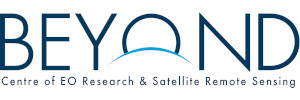The BEYOND Center is a living entity that constantly evolves its services through the development new scientific methods, and the exploitation of emerging technologies and state-of-the-art infrastructure for the extraction of higher level information and knowledge for the benefit of the citizen and the environment.
It is a key objective of the BEYOND Center to follow the Big Data paradigm shift and the ICT penetration into the Earth Observation domain. We have been actively participating into flagship European projects, conducting research and developing services in new domains other than natural disasters, which demand or benefit from the exploitation of enabling technologies; such as Machine Learning (ML), Artificial Intelligence (AI) and Distributed Computing.
Over that last years the team has conducted advanced research and had developed mature services, through the combination of mature Remote Sensing technologies and state-of-the-art ICT and AI solutions, in the domains of sustainable agriculture, food security, geohazards and energy.
Alternative application domains / Big Earth Data Analytics
The Big Earth Data that we continuously receive from multiple sources, such as satellites, in situ sensors is multi-dimensional by nature. In order to effectively exploit these data, we need to efficiently combine information of different spatial, temporal and spectral characteristics.
Therefore, we need to efficiently organize this kind of datasets, into structures that will in turn feed complex AI algorithms. The Data Cube structure constitutes a scalable solution of multi-dimensional databases proposed and adapted the last years for the Big Earth Data domain. Data Cubes gain more and more popularity in the EO sector and evolve rapidly towards solving issues, such as the multiple data sources fusion, centralized access, analysis ready data presentation, storage etc.
Below follow some indicative success stories of utilizing advance AI and ICT technologies for the thematic areas of Agriculture, Geo-hazards and Energy.
- Earth Observation, Machine Learning and Distributed Computing at the service of Food Security monitoring (EOPEN H2020 project)
Food security requires the large-scale monitoring of agricultural land and the extraction of quality knowledge from EO data at the national level. It becomes apparent that certain Big Data considerations come into play, including the effective storage and processing of an immense volume of data (tens of TBs). For this reason, we have utilized High Performance Data Analytics environments to store our data, using the Hadoop Distributed File System (HDFS) and to employ distributed implementations of supervised (Random Forest) and unsupervised learning (K-Means), using the analytics engine Apache Spark. More information can be found in this link.
- Earth Observation (EO), Machine Learning (ML) and High Performance Computing (HPC) at the service of Solar energy monitoring and short-term forecasting (EuroGEO e-shape project)
The continuous monitoring and short-term forecasting of solar energy potential at continental level require ultra fast radiative transfer models (RTM), high resolution EO data and sophisticated prediction algorithms. To this direction we exploit ML and distributed computing architectures for instantaneous RTM simulations (i.e. 25 million/min), motion flow techniques for cloud microphysics forecasting (up to 6 hours ahead at 15-min intervals) as well as Copernicus Atmosphere Monitoring Service (CAMS) and EUMETSAT's Nowcasting Satellite Application Facilities (SAFNWC) for realistic aerosols and clouds impact on solar power. The use of HPC provides operationally and in real-time a tremendous solar data production flow (i.e. 550 Gb/day), forming the nextSENSE energy management system for the European and North African region. More information can be found here.
- Earth Observation (EO), Machine Learning (ML) and Distributed Computing Computing (HPC) for landslide susceptibility mapping (NextGEOSS project)
Systematic ground deformation mapping is critical for a number of applications that model the impact of geophysical (e.g. earthquakes, volcanoes, landslides) and manmade (water extraction, mining, underground works, dams construction) activities, and assess geohazard risk. We have re-engineered a Persistent Scatterer Interferometry processing chain for distributed execution on a cloud environment. We have used this chain to exploit the frequent Sentinel-1 acquisitions and enrich a landslides inventory for a large area in Greece. Using this inventory as input data we have trained a statistical model that maps landslide driving factors (topography, climate/meteorology, geology, etc.) to the observations, creating a landslides susceptibility product. More information can be found here.

